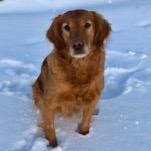Canada Goose og Parajumpers jakke = dyremishandling?
-
Hvem er aktive 0 medlemmer
- Ingen innloggede medlemmer aktive
-
Nye innlegg
-
Av Wilhelmina · Skrevet
Vi hadde en elghund som stod og ulte ved døra hvis det var løpetisper innen en mils radius (satt på spissen), og en annen elghund som ikke brydde seg i det hele tatt, så det er nok i alle fall til en viss grad individbetinget. Ellers har jeg bare hatt relativt små hunder (6-8 kg), men det har kun vært tisper, og de har vært veldig enkle mtp. løpetid (lite blod, ikke noe særlig hormonpåvirking mentalt utover at det skal markeres hver 5. meter på tur). simira nevner livmorbetennelse, jeg vet ikke om det er mer vanlig på småraser, men min forrige hund fikk i alle fall det. Men skal man ikke drive med avl eller andre raserelaterte aktiviteter er det jo ikke verre enn at man kastrerer. -
Hvordan er rasene hunden er blanding av? Og ikke minst foreldrene? Det er jo ulempen med blanding, det er vanskelig å gjøre grundig research, men foreldrene og evt. tidligere kull kan jo gi indikasjoner. Hvis det er bevisst blandingsavl så ville jeg uansett håpet at de ikke ville avlet på en hannhund som er slik, men samtidig så ville de da kanskje ikke avlet på blanding heller, om de var opptatte av genetikk. Jeg kan ikke veldig mye om miniatyrhunder, jeg har kjent et par hannhunder som var slik du beskriver, og et par som er helt greie. Når det er sagt er jo tispene også "kjent" for mer gneldring og innbilte svangerskap og livmorbetennelse, så man velger jo litt sine onder.
-
Av Hufflepuff · Skrevet
Hei! Jeg er helt ny i liten-hund-verden. Har tidligere hatt springer spaniel, boxer og schæfer, men skal nå få en liten blandingsrase. Jeg er så usikker på valget av hannhund eller tispe! Personlig har jeg ikke en sterk preferanse, har hatt to tisper og en hannhund, og heller nok kanskje mer mot hannhunder. Men jeg hører fra mange med små hunder at hanner kan være veldig vanskelig å få stuerene, at de markerer inne og at de er så stressa rundt løpetid i nabolaget feks at de står og uler ved døra osv. Dette er ikke noe jeg har vært borti med store raser, verken min egen eller venner sine (vært aktiv i NRH og NBF-miljø i 15 år, så vært borti en del forskjellige raser) i det hele tatt, så er det en typisk type atferd for små hunder, eller er det mer individbetinget? Vi legger så klart til rette for rotrening og passe aktivitetsnivå osv osv. Hadde vært fint å høre noe annet enn skrekkhistorier om små hunder, for akkurat nå lener jeg veldig mot tispe. -
Av Martine432 · Skrevet
Vi har hittil foret vår valp på 13 uker med fire måltider om dagen og har planer om å gå ned til tre måltider om dagen. Ved fire måltider ga vi frokost ca 07-07.30, lunsj 12, middag 16 og kveldsmat 19.30. hvilke tidspunkter forer dere valpene deres og hva har fungert for dere? -
Hei @Betan, min erfaring strekker seg fra 2002 da jeg fikk min første bull-hund. Min første ambull ble født i 2007 og jeg har hatt mange verv i det norske raseklubbens styre, nå sitter jeg i den svenske klubbens styre. Jeg har som oftest hunder i par og jeg er utdannet innefor atferd men også jobbet som hundetrener i mange år. Nå for tiden konkurerer jeg med min ambull-tispe. Vi er i kl 3 i RL f.eks og har flere sporprøver bak oss, tatt i Sverige. Så erfaringen strekker seg fra egne hunder til mange av norges og sveriges ambuller. Holder det?
-
-
Nylig opprettede emner



.jpg.881e69831dc81b9aa212e4851e5b85d1.thumb.jpg.bbefa843ff756844778e12c5d0bd9cdd.jpg)
Recommended Posts
Join the conversation
You can post now and register later. If you have an account, sign in now to post with your account.